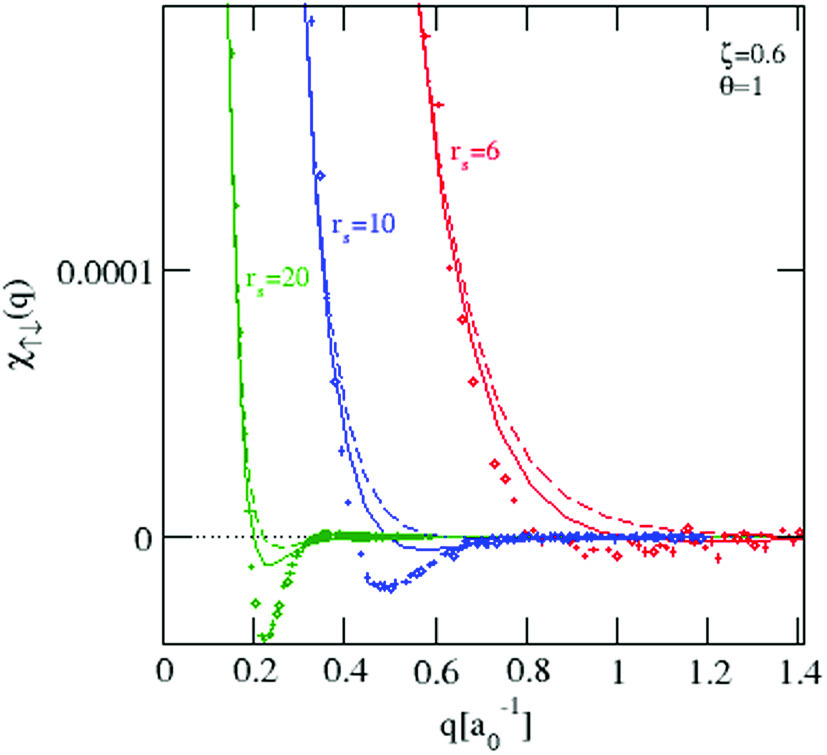https://doi.org/10.1140/epjb/s10051-025-00916-3
Regular Article - Solid State and Materials
A dynamic mean-field study of spin-resolved static density response of warm-dense homogeneous electron gas
Department of Physics, Kurukshetra University, 136 119, Kurukshetra, Haryana, India
Received:
21
January
2025
Accepted:
3
April
2025
Published online:
19
April
2025
Motivated by recent ab initio path-integral Monte Carlo (PIMC) simulations by Dornheim et al. (Phys Rev Res 4:033018, 2022), we have studied the role of dynamic electron correlations in determining the spin-resolved static density response of warm-dense homogeneous electron gas having arbitrary spin-polarization  . To this endeavor, we have used the quantum or dynamical version of the self-consistent mean-field approximation of Singwi, Tosi, Land, and Sjölander (STLS), the so-called qSTLS approach. Particularly, we have calculated the spin-resolved components of static density response function, static structure factor, and local-field correction at selected
. To this endeavor, we have used the quantum or dynamical version of the self-consistent mean-field approximation of Singwi, Tosi, Land, and Sjölander (STLS), the so-called qSTLS approach. Particularly, we have calculated the spin-resolved components of static density response function, static structure factor, and local-field correction at selected  and a wide range of electron density/coupling
and a wide range of electron density/coupling  and degeneracy temperature
and degeneracy temperature  . We compare our results directly with PIMC simulations and lower order theories such as (static) STLS and random phase approximation (RPA). The comparative analysis reveals that in metallic density regime (
. We compare our results directly with PIMC simulations and lower order theories such as (static) STLS and random phase approximation (RPA). The comparative analysis reveals that in metallic density regime ( ), the dynamics of correlations is imperceptible in static density response and static structure factor, with both qSTLS and STLS exhibiting excellent agreement with PIMC. However, its influence grows continuously with increasing effective electron coupling (
), the dynamics of correlations is imperceptible in static density response and static structure factor, with both qSTLS and STLS exhibiting excellent agreement with PIMC. However, its influence grows continuously with increasing effective electron coupling ( ), manifesting as a better alignment of qSTLS predictions with PIMC data as compared to STLS. Interestingly, it accounts for, above a sufficiently large
), manifesting as a better alignment of qSTLS predictions with PIMC data as compared to STLS. Interestingly, it accounts for, above a sufficiently large  , the emergence of a small negative portion (though qualitatively) in the PIMC spin-offdiagonal static density response function for wave vectors characteristic of average inter-electron spacing. An assessment of spin-resolved correlations brings out that
, the emergence of a small negative portion (though qualitatively) in the PIMC spin-offdiagonal static density response function for wave vectors characteristic of average inter-electron spacing. An assessment of spin-resolved correlations brings out that  correlations are underestimated, while their
correlations are underestimated, while their  counterpart are overestimated, with a fortunate cancellation (closely at small coupling
counterpart are overestimated, with a fortunate cancellation (closely at small coupling  ) between their effects in the spin-summed static response and structure factor. Nevertheless, the spin components of self-consistent static local-field correction factor match with PIMC estimate mainly at small wave vectors, with even a qualitative mismatch between the two at
) between their effects in the spin-summed static response and structure factor. Nevertheless, the spin components of self-consistent static local-field correction factor match with PIMC estimate mainly at small wave vectors, with even a qualitative mismatch between the two at  and
and  for the
for the  component at large wave vectors, where the former saturates to a positive value as against a negative tail in the latter.
component at large wave vectors, where the former saturates to a positive value as against a negative tail in the latter.
Copyright comment Springer Nature or its licensor (e.g. a society or other partner) holds exclusive rights to this article under a publishing agreement with the author(s) or other rightsholder(s); author self-archiving of the accepted manuscript version of this article is solely governed by the terms of such publishing agreement and applicable law.
© The Author(s), under exclusive licence to EDP Sciences, SIF and Springer-Verlag GmbH Germany, part of Springer Nature 2025
Springer Nature or its licensor (e.g. a society or other partner) holds exclusive rights to this article under a publishing agreement with the author(s) or other rightsholder(s); author self-archiving of the accepted manuscript version of this article is solely governed by the terms of such publishing agreement and applicable law.





